Dr.Teruo Higa’s
Living A Dream
- 2025
- Apr:#204 How EM Use Has Spread Throughout the Philippines
- Mar:#203 How to Use EM to Fundamentally Solve the Problem of Agricultural Residue Burning
- Feb:#202 The Spread of EM technology in Germany
- Jan:#201 The 2nd Ichiro Masaki Memorial Universal Village EM International Conference
- Jan:#200 Cleanup of the Ala Wai Canal in Hawaii, where social bonds are strengthened using EM
- 2024
- Nov:#199 EM trials in India with bananas, tomatoes, and pomegranates
- Oct:#198 The Steadily Evolving EM Nature Farming Method at the Blue Sky Palace - Part 8
- Sep:#197 The Steadily Evolving EM Nature Farming Method at the Blue Sky Palace - Part 7
- Aug:#196 The Steadily Evolving EM Nature Farming Method at the Blue Sky Palace - Part 6
- Jul:#195 The Steadily Evolving EM Nature Farming Method at the Blue Sky Palace - Part 5
- Jun:#194 Steadily Evolving EM Nature Farming Method at the Blue Sky Palace - Part 4
- May:#193 Steadily Evolving EM Nature Farming Method at the Blue Sky Palace - Part 3
- May:#192 Steadily Evolving EM Nature Farming Method at the Blue Sky Palace - Part 2
- Apr:#191 Steadily Evolving EM Nature Farming Method at the Blue Sky Palace
- Mar:#190 Quantum Mechanical Effects of EM Gravitron Charcoal
- Mar:#189 The barrier space in Okinawa (Ryukyu Islands) has risen to another dimension
- Jan:#188 Sixty Days after Typhoon No.6
- 2023
- Oct:#187 Supermassive Typhoon No.6 and Subsequent Typhoon No. 11
- Sep:#186 Massive Typhoon No.6 that swallowed the Ryukyu Islands Graviton barrier
- Sep:#185 August 8th is World “EM Mudball Day”
- Aug:#184 A disease-free life depends on the health of the intestinal microbiome.
- Jul:#183 Trial and Error at the Blue-Sky Palace, Part 3
- Jun:#182 Trial and Error at the Blue-Sky Palace, Part 2
- Apr:#181 Trial and Error at the Blue-Sky Palace
- Mar:#180 Ala Wai Canal Cleanup Project in Waikiki, Hawaii
- Feb:#179 High-Yield, High-Quality Rice Production Using EM
- Feb:#178 The Progress the "Soil Preparation Workshop" of the Oishi 3-chan Club (Part 2)
- Jan:#177 Organic Farming Instructional Manual Using EM
- 2022
- Nov:#176 The Typhoon Situation in Okinawa in 2022
- Sep:#175 Third-Party Verification of the Graviton barrier in Okinawa Part-2
- Sep:#174 Third-Party Verification of the Graviton barrier in Okinawa
- Aug:#173 Ecosystem Changes Observed in Okinawa in 2021 Part-5
- Jun:#172 Ecosystem Changes Observed in Okinawa in 2021 Part-4
- May:#171 Ecosystem Changes Observed in Okinawa in 2021 Part-3
- Apr:#170 Ecosystem Changes Observed in Okinawa in 2021 Part-2
- Mar:#169 Koizumi Farm in Kamakura Continues to Evolve
- Feb:#168 Ecosystem Changes Observed in Okinawa in 2021 Part-1
- 2021
- Dec:#167 Enjoying EM Technology While Enriching the Local Ecosystem
- Nov:#166 A Case Study of the Use of EM in a Next Generation Free School in Tune with the Cycles of Nature
- Oct:#165 Typhoon conditions and flowers in Okinawa from August to October
- Sep:#164 Re-learning the origins of river purification using EM Cleaning up the Dairyuji River in Senami (Murakami City, Niigata Prefecture)
- Aug:#163 Measures Against Natural Disasters and Re-learning the Starting Point of EM
- Jul:#162 Summary of FFC (Foods for Children) Okinawa Forum 2021
- Jun:#161 Restoring the Vigor of an Old Tree and Purifying the Environment with EM Technology That Even an Amateur Can Do
- May:#160 The Public is Beginning to Recognize the Use of EM Smokeless Carbonizers
- Apr:#159 EM Hado (EM Graviton) that exerts quantum superposition effect over time
- Mar:#158 Virus-free Okinawan Plants Through Use of an EM Graviton Barrier
- Jan:#157 Enjoyable Farming for Self-Sufficiency that Even Amateurs Can Do
- 2020
- Dec:#156 EM quantum energy effect occurring in Okinawa
- Nov:#155 Implementing EM graviton farming as a flood countermeasure for apple orchards
- Oct:#154 The Latest Book on the Practical Uses of EM "You Are the One Who Draws Out the Power of Microorganisms," by Chizuko Nomoto
- Sep:#153 Application of EM technology to long periods of rain, lack of sunshine, storms, heavy rains, etc.
- Aug:#152 EM application in Kitanakagusuku village plant waste recycling yard
- Jul:#151 Natural Disaster Countermeasures Using EM Technology: Part 2
- Jul:#150 Natural Disaster Countermeasures Using EM Technology
- May:#149 How to make your home and workplace an energy spot by living a complete EM lifestyle: creating the ultimate source of health and environmental purification
- Apr:#148 EM, Viruses and the Pandemic
- Apr:#147 New agriculture applying quantum mechanics Part 2
- Apr:#146 New agriculture applying quantum mechanics
- Apr:#145 Wonderful EM Miracle
- 2019
- Nov:#144 The movie “Revival II” and the reality of Fukushima
- Oct:#143 Boundary dome and foliar spraying of EM・X GOLD and EM 3
- Oct:#142 Kirakira (Sparkling) Summer Vegetable Festa in 2019
- Aug:#141 Excessive salt inevitably causes salt damage
- Jul:#140 Diverse applications of charcoal Part 3
- Jun:#139 Diverse applications of charcoal Part 2
- Jun:#138 Diverse applications of charcoal
- Jun:#137 Purification power of salt
- May:#136 The degree of soil contamination is a reflection of the microflora
- May:#135 Definitive use of EM barriers to deal with typhoons
- May:#134 Implementing authentic Nature Farming
- May:#133 How to enhance healthy Hado (wave energy) by EM
- May:#132 Eating Dirt (Soil)
- May:#131 Hado (Wave energy) involved in health
- May:#130 Reaffirming EM technology to realize the essence of agriculture
- May:#129 The 2nd EM Producer Networking Meeting
- Apr:#128 Understanding the application of seawater and salt in crop cultivation
- Apr:#127 Prevention of Disasters by EM Technology
- Mar:#126 Quantum overlay effective utilization of EM
- Jan:#125 EM Disaster Recovery Support Projects in 2017
- 2018
- 2017
- Aug:#121 Escape from conventional agricultural traps
- Jul:#120 Limitation and important caveats regarding utilization of salt
- Jun:#119 EM Technology to Break Through the Limits of Pesticide-Free Strawberries
- May:#118 Application of barriers using EM rectification force
- Apr:#117 The 1st EM Produce Growers' Networking Conference
- Mar:#116 Sumizo kun: The Ultimate Versatile Carbonization Equipment
- Feb:#115 How to make and use simple carbonized and rectified ash
- Jan:#114 Achievements of 2016
- 2016
- Dec:#113 Definitive Measures Against Typhoons
- Nov:#112 International Conference on Universal Village
- Oct:#111 90% of Your Body is Microbes
- Sep:#110 Disaster Countermeasures Using EM
- Aug:#109: Changes in the Natural Environment by EM Barrier Domes in Okinawa
- Jul:#108: Multi-purpose Utilization of Activated EM with Seawater and Salt
- Jun:#107: Marine Day, when EM Mudballs and Activated EM are Applied Throughout Japan
- May:#106: The Function of EM and Gravitational Waves–Part 3
- Apr:#105: The Function of EM and Gravitational Waves–Part 2
- Feb:#104: The Function of EM and Gravitational Waves
- Feb:#103: The Importance of Phototrophic Bacteria in EM
- 2015
- Dec:#102: Results of Environmental Forum "Utsukushima EM Paradise" 2015
- Nov:#101: Environmental Forum "Utsukushima EM Paradise" 2015
- Oct:#100: A New Phase of Limit Breakthrough Using EM
- Sep:#99: A New Phase of Limit Breakthrough through EM
- Aug:#98: The Tokyo Bay Area Began Creating a Truly Livable Hometown
- Jul:#97: Rectifying Effects of EM
- Jun:#96: Lake Suwa Sousei lecture
- May:#95: In Order to Further Ensure Limit Breakthrough
- Apr:#94: Theatrical Release of the Documentary Film SOSEI-Revival to Enlighten People on the New Possibilities of Microorganisms
- Mar:#93: What Underlies Limit Breakthrough (Part 2)
- Feb:#92: EM Functions to Break Through Limits
- Jan:#91: At the Start of 2015
- 2014
- Dec:#90: Looking Back at 2014
- Nov:#89: Shikoku EM FESTA 2014, Virtuous Circle Conference in Matsuyama, Ehime Prefecture
- Oct:#88: Using EM to Deal with Weather Disasters (Part 2)
- Sep:#87: Current Status of Radioactivity Measures Using EM in Fukushima
- Aug:#86: APNAN (Asia Pacific Natural Agriculture Network) 25th Anniversary Conference in 2014
- Jul:#85: Using EM to Deal with Weather Disasters
- Jun:#84: Substantial Improvement of Soil
- May:#83: The Energy Rectification Force of EM
- Apr:#82: The Annual 18th EM Technology Exchange Meeting and Tohoku Conference in Shichigahama
- Mar:#81: Salmon going upstream in Kitaura (Kasumigaura)
- Feb:#80: The Microbiome Again
- Jan:#79: Inauguration of the Federation of Diet Members Who Use and Apply Effective Microorganisms
- 2013
- Dec:#78: Receiving an Honorary Doctoral Degree from Rajamangala University of Technology in Thailand
- Nov:#77: The Use of EM in School Education in Bhutan
- Oct:#76: Well of Bonding
- Sep:#75: The Background to EM Not Being Employed by Public Institutions to Deal with Radiation
- Aug:#74: Dealing with Disaster: Using EM in Crisis Management
- Jul:#73: EM Events on Ocean Day
- Jun:#72: Using EM to Deal With Heat Stroke and Summer Heat Fatigue
- May:#71: An EM Model Town in Malaysia
- Apr:#70: Steps the Japanese Government is Taking to Deal with Radiation: Are They Really Safe?
- Mar:#69: EM Group Disaster Reconstruction Aid Project in Fukushima
- Feb:#68: EM and Microbiomes (Microbial Flora)
- Jan:#67: A Necessary Evil is Still Evil
- 2012
- Dec:#66: The 17th National EM Technology Exchange Conference / Hokkaido Conference in Sapporo
- Nov:#65: EM Forum 2012 in Okinawa and the Environmental Forum in Fukushima
- Oct:#64: 2012 EM Forum
- Sep:#63: A New Earth Saving Revolution
- Aug:#62: The Asahi Newspaper’s Misguided Reports About EM
- Jul:#61: Using EM in Radioactive Contamination Measures in Fukushima Prefecture
- Jun:#60: The Effects of Using EM to Inhibit the Absorption of Radioactivity as Confirmed in Fukushima
- May:#59: Recovery Support for the Great East Japan Earthquake
- Apr:#58: The Royal Kingdom of Thailand, in which EM Functions as a Set Government Policy
- Mar:#57: Report on the Measures Taken by Kingdom of Thailand Using EM to Deal with Polluted Water
- Feb:#56 EM™ as Part of National Policy in Thailand to Deal with Sanitation Issues Resulting from the Flood of 2011
- Jan:#55 The Law of Syntropy (Revitalization)
- 2011
- Dec:#54 EM Forum 2011
- Nov:#53 Shikoku EM Festa 2011- Zenjunkan no Wa (Virtuous Circle) Tokushima Conference in Naruto -
- Oct:#52 The Mystery of Interim Safety Values for Radioactive Material
- Sep:#51 Successful Radiation Countermeasures Using EM
- Aug:#50 Events on Sea Day in which EM Mud Balls are Thrown into the Water and Activated EM is Applied.
- May:#47 Dealing with the Damage Caused by the Eastern Japan Earthquake
- Apr:#46 Eastern Japan Earthquake
- Mar:#45 The 16th National EM Technology Hokuriku Conference in Fukui
- Feb:#44 More Thoughts on Avian Influenza and Foot-and-Mouth Disease
- Jan:#43 Happy New Year!
- 2010
- Dec:#42 Shikoku EM FESTA 2010・Zenjunkan no wa (Virtuous Circle) Fellowship Conference in Tobe, Ehime Prefecture
- Nov:#41 EM Forum 2010
- Oct:#40: My Thanks to the EM™ Volunteers Who Helped in the Fight Against Foot-and-Mouth Disease in Miyazaki Prefecture
- Sep:#39 International EM Mud Ball Day
- Jul:#37 Poland EM Forum 2010
- Jun:#36 EM Countermeasures Against Foot-and-Mouth Disease
- May:#35 Abnormal Weather
- Apr:#34 EM Activities in Thailand: Finding Solutions to the Challenges Facing the Nation
- Mar:#33 New Developments in the Evolution of EMTM in Thailand
- Feb:#32 Results Starting to Be Seen at the Mikasa Project
- Jan:#31 Towards an EM-Use Society
- 2009
- Dec:#30 EM Summit
- Nov:#29 The System in Penang State in Malaysia that Made the World EMTM Mudball Day a Success
- Oct:#28 The "World EM Mudball Day" in Malaysia
- Sep:#27 Validating EMTM Medicine: Case Study Reports from EM Users 2009. (Part 3)
- Sep:#26 Validating EMTM Medicine: Case Study Reports from EMTM Users 2009. (Part 2)
- Jul:#25 Validating EMTM Medicine: Case Study Reports from EMTM Users 2009. (Part 1)
- Jun:#24 Activities to Disseminate EM-Focused Nature Farming in China
- May:#23 Use of EMTM in Response to Swine Flu
- Apr:#22 Using EM to Solve Public Administrative Costs
- Mar:#21 Reaffirming the Versatility of EM
- Jan:#20 The Beginning of a New Era
- 2008
#183 Trial and Error at the Blue-Sky Palace, Part 3


Blue-Sky Palace ships more than ten kilograms of bananas every week. We are also able to ship over three kilograms per week of the Yunnan Hyakuyaku, Anredera cordifolia, which I introduced in the previous issue. In the summer the banana crop sometimes exceeds twenty kilograms, and we promote them by giving bananas away as gifts to visitors and other interested parties who understand their value.
Since some eight years ago the Ryukyu Islands have had functioning rectification barriers, and since then no deadly typhoons have hit the islands. Before that, once or twice each year, from mid-July to September, strong typhoons made landfall, devastating tall fruit trees and other varieties, making it impossible to raise bananas in Okinawa as a regularly cultivated agricultural crop.
However, now there is an abundant harvest of bananas everywhere in Okinawa, and industrial development of them as a crop is possible. In response to the corona pandemic, the Kekkai barrier's power was increased, and since then most viruses have disappeared. Papayas, for example, which were difficult to cultivate for long periods due to viral infections, are now completely virus-free, and older trees that had been infected with the virus in the past are now growing normally.
Since some eight years ago the Ryukyu Islands have had functioning rectification barriers, and since then no deadly typhoons have hit the islands. Before that, once or twice each year, from mid-July to September, strong typhoons made landfall, devastating tall fruit trees and other varieties, making it impossible to raise bananas in Okinawa as a regularly cultivated agricultural crop.
However, now there is an abundant harvest of bananas everywhere in Okinawa, and industrial development of them as a crop is possible. In response to the corona pandemic, the Kekkai barrier's power was increased, and since then most viruses have disappeared. Papayas, for example, which were difficult to cultivate for long periods due to viral infections, are now completely virus-free, and older trees that had been infected with the virus in the past are now growing normally.
The flowers of bulbs and perennial plants, which were severely damaged by virus, are now blooming as vibrantly as if they were different varieties.
Flower cultivation used to require intensive management, but now it is possible to create magnificent flower beds without special handling or care. Flowers are blooming beautifully not only at schools, but also in public squares, and perennials such as Madagascar periwinkle, Pentas, Angelonia, and others are flowering all year round.
Naturally, the introduction of a variety of flowers will enhance the overall strength of the ecosystem.
In the outer areas of the Blue-Sky Palace, fruit trees such as guava, Java apple, shikuwasa, Hirami lemon (small tangerine oranges), pitanga, Brazilian cherry, and acerola are bearing abundant fruit while also functioning as windbreaks. We have also planted dracaena, croton, hibiscus, etc., in various spots to liven up the garden by adding more color.
Since this is all no-tillage cultivation, we can plant anything anywhere, so we also try to plant flowers to aid in weed control. We have just begun doing this, but below I'd like to show some of the flowers on our office veranda and in the field.
Flower cultivation used to require intensive management, but now it is possible to create magnificent flower beds without special handling or care. Flowers are blooming beautifully not only at schools, but also in public squares, and perennials such as Madagascar periwinkle, Pentas, Angelonia, and others are flowering all year round.
Naturally, the introduction of a variety of flowers will enhance the overall strength of the ecosystem.
In the outer areas of the Blue-Sky Palace, fruit trees such as guava, Java apple, shikuwasa, Hirami lemon (small tangerine oranges), pitanga, Brazilian cherry, and acerola are bearing abundant fruit while also functioning as windbreaks. We have also planted dracaena, croton, hibiscus, etc., in various spots to liven up the garden by adding more color.
Since this is all no-tillage cultivation, we can plant anything anywhere, so we also try to plant flowers to aid in weed control. We have just begun doing this, but below I'd like to show some of the flowers on our office veranda and in the field.
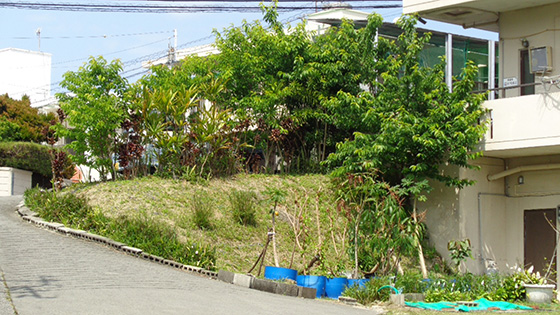

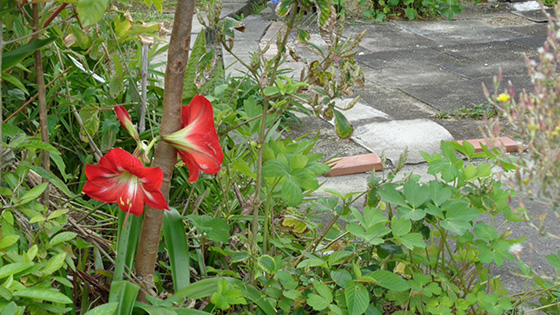
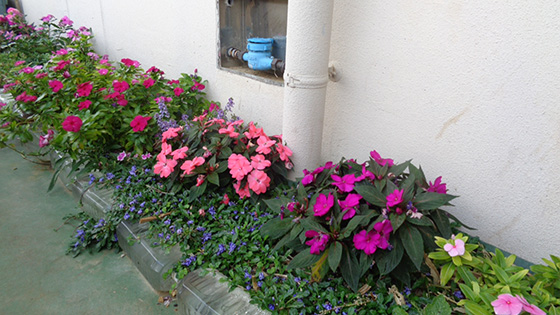
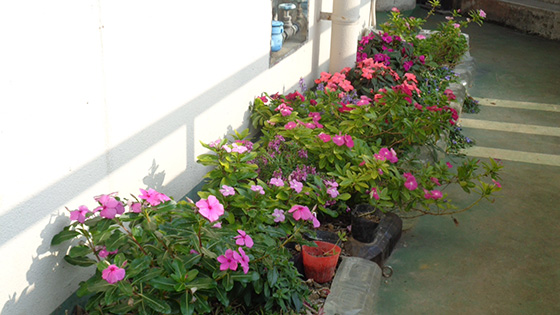
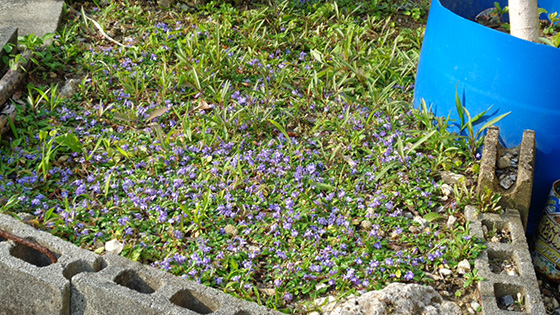
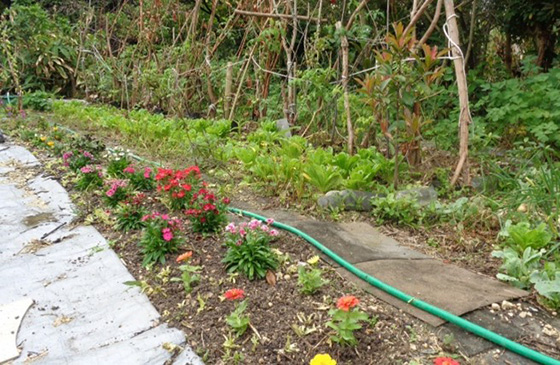
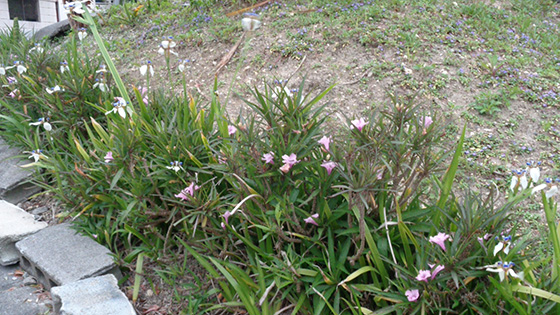
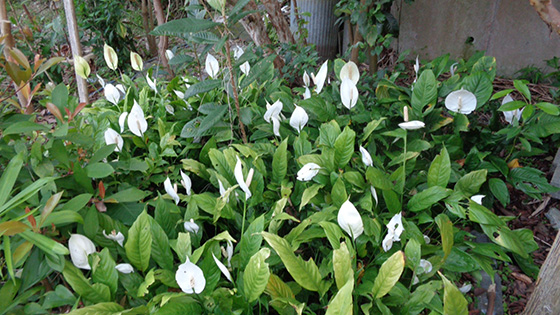
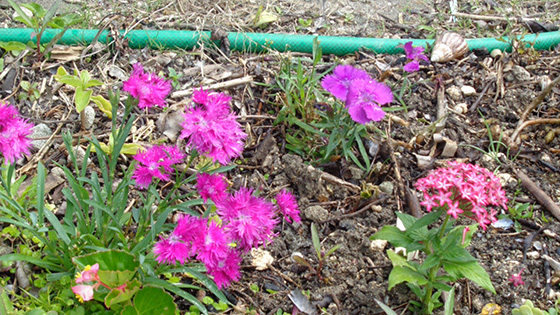
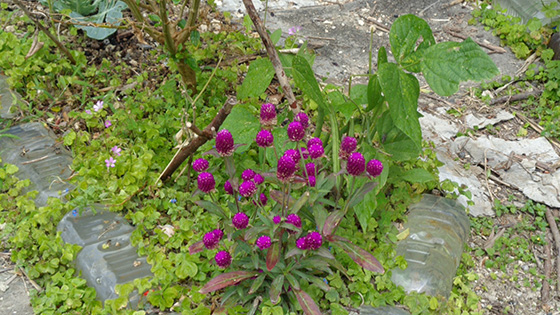
News about flowers and a dolphin in Okinawa
Sightings of whales and dolphins in Tokyo Bay and Osaka Bay, and of finless porpoises in Nagoya Harbor, etc. have been a hot topic recently, and all are places where EM has been applied and become established for many years. Makiminato fishing port, where a dolphin was sighted, is also a port where EM from the dam at the University of the Ryukyus campus flows down into the Makiminato coast.
Sightings of whales and dolphins in Tokyo Bay and Osaka Bay, and of finless porpoises in Nagoya Harbor, etc. have been a hot topic recently, and all are places where EM has been applied and become established for many years. Makiminato fishing port, where a dolphin was sighted, is also a port where EM from the dam at the University of the Ryukyus campus flows down into the Makiminato coast.
Irukanda flowers are in full bloom in Izumi, Motobu Town
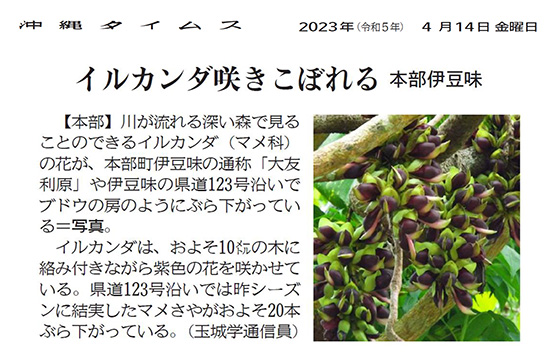
Okinawa Times, Friday, April 14, 2023
Grape-like clusters of Irukanda (leguminous) flowers are found in the deep forest where the Motobu River flows, in Izumi, Motobu Town, commonly known as Otomo Rigen, and also along Prefectural Road 123 in Izumi, Motobu Town (see photo). Irukanda are purple flowers that wrap around the 10 meter high tree. Along Prefectural Route 123, about 20 bean pods that bore fruit last season are hanging down. (Reported by Manabu Tamaki)
Grape-like clusters of Irukanda (leguminous) flowers are found in the deep forest where the Motobu River flows, in Izumi, Motobu Town, commonly known as Otomo Rigen, and also along Prefectural Road 123 in Izumi, Motobu Town (see photo). Irukanda are purple flowers that wrap around the 10 meter high tree. Along Prefectural Route 123, about 20 bean pods that bore fruit last season are hanging down. (Reported by Manabu Tamaki)
Golden Days in Full Bloom
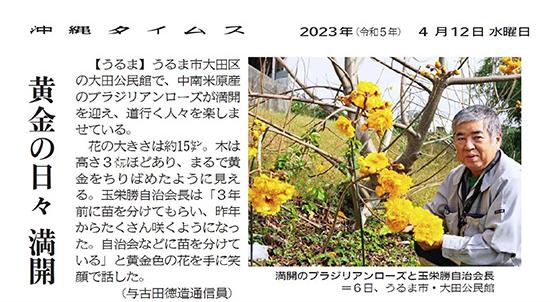
Okinawa Times, Wednesday, April 12, 2023
Blooming flowers in Uruma Enjoying the blooming flowers along the road Brazilian Rose trees, native to Central and South America, are in full bloom at the Ota Community Center in Ota-ku, Uruma City, delighting passers-by. The flowers are about 15 cm in size, and the tree itself is about 3 meters tall and looks like it is studded with gold. Mr. Masaru Tamae, the head of the community association remarked that, “I received the seedlings three years ago, and since last year so many flowers have been blooming. I have been sharing the seedlings with neighborhood associations." He had a big smile as he held the golden flowers in his hands. (Reported by Tokuzo Yokota)
Blooming flowers in Uruma Enjoying the blooming flowers along the road Brazilian Rose trees, native to Central and South America, are in full bloom at the Ota Community Center in Ota-ku, Uruma City, delighting passers-by. The flowers are about 15 cm in size, and the tree itself is about 3 meters tall and looks like it is studded with gold. Mr. Masaru Tamae, the head of the community association remarked that, “I received the seedlings three years ago, and since last year so many flowers have been blooming. I have been sharing the seedlings with neighborhood associations." He had a big smile as he held the golden flowers in his hands. (Reported by Tokuzo Yokota)
Snapping photos of a flowering tree, wondering what it's called.
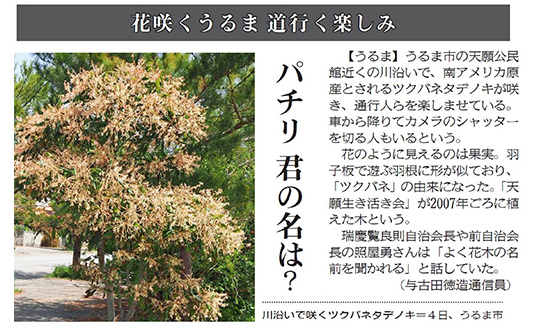
Okinawa Times, Wednesday, April 12, 2023
Flowers blossoming in Uruma
Enjoying the Blooming flowers while passing along the road
Along the river near Tengan Community Center in Uruma City, Tsukubane Tadenoki, Triplaris americana, which is said to be native to South America, is blooming now and delighting the eyes of passersby. Some people even get out of their cars and snap photos of the flowers. But what looks like a flower is actually a fruit. The shape of the fruit resembles the feathers on a battledore shuttlecock, which is the origin of their name, “tsukubane,” (a feathery, colorful shuttlecock). The tree was planted around 2007 by the Tengan Ikiiki Kai. Yoshinori Zukeran, the neighborhood association president, and Isamu Teruya, the former president said, “We are often asked the name of this flowering tree." (Reported by Tokuzo Yokota)
Flowers blossoming in Uruma
Enjoying the Blooming flowers while passing along the road
Along the river near Tengan Community Center in Uruma City, Tsukubane Tadenoki, Triplaris americana, which is said to be native to South America, is blooming now and delighting the eyes of passersby. Some people even get out of their cars and snap photos of the flowers. But what looks like a flower is actually a fruit. The shape of the fruit resembles the feathers on a battledore shuttlecock, which is the origin of their name, “tsukubane,” (a feathery, colorful shuttlecock). The tree was planted around 2007 by the Tengan Ikiiki Kai. Yoshinori Zukeran, the neighborhood association president, and Isamu Teruya, the former president said, “We are often asked the name of this flowering tree." (Reported by Tokuzo Yokota)
One Million Easter Lilies Color the Island
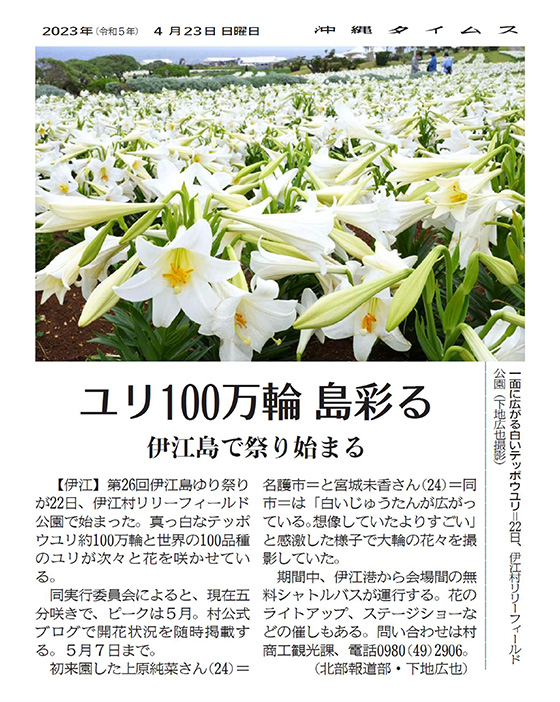
Okinawa Times, Sunday, April 23, 2023
Festival Begins on Ie Island
The 26th Ie Island Lily Festival began on April 22nd at Lily Field Park in Ie Village. About one million pure white easter lilies and 100 varieties of lilies from around the world are blooming one after another.
According to the committee in charge of the festival, the lilies are currently in half bloom and will peak in May. From now until May 7th the village’s official blog will post information on the flowers' blossoming status.
Junna Uehara, 24 and Mika Miyagi, 24, both from Nago City, who visited the park for the first time, said, “The white carpet of flowers is more amazing than I'd imagined,” and they excitedly kept on photographing the large flowers.
During the festival, free shuttle buses will run from Ie Port to the venue. There are also events such as illumination of the flowers and stage shows. For inquiries, please contact the Village Commerce, Industry and Tourism Division at 0980 (49) 2906. (Hiroya Shimoji, Northern Press Department)
Festival Begins on Ie Island
The 26th Ie Island Lily Festival began on April 22nd at Lily Field Park in Ie Village. About one million pure white easter lilies and 100 varieties of lilies from around the world are blooming one after another.
According to the committee in charge of the festival, the lilies are currently in half bloom and will peak in May. From now until May 7th the village’s official blog will post information on the flowers' blossoming status.
Junna Uehara, 24 and Mika Miyagi, 24, both from Nago City, who visited the park for the first time, said, “The white carpet of flowers is more amazing than I'd imagined,” and they excitedly kept on photographing the large flowers.
During the festival, free shuttle buses will run from Ie Port to the venue. There are also events such as illumination of the flowers and stage shows. For inquiries, please contact the Village Commerce, Industry and Tourism Division at 0980 (49) 2906. (Hiroya Shimoji, Northern Press Department)
Iris (Okulaleluka) Colors the Rice Fields
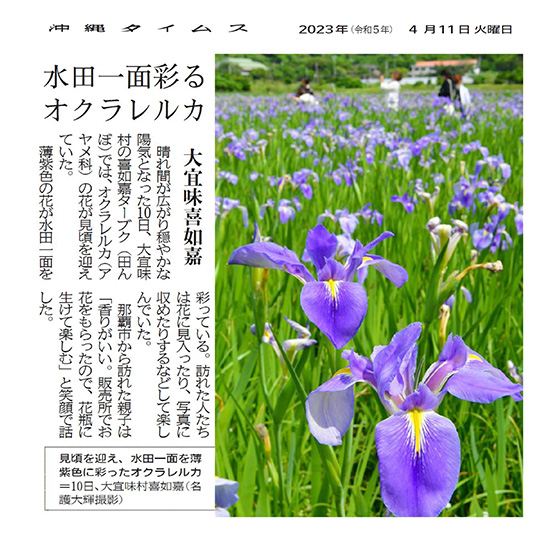
Okinawa Times, Sunday, April 11, 2023
Iris (Okulaleluka) Colors the Rice Fields
On April 10th, a calm and sunny day, Iris (Okulaleluka) flowers were at their best in the rice paddies of Kijoka Tabuku (rice fields) in Ogimi Village. Light purple flowers decorated the rice paddies, and visitors enjoyed seeing them and taking pictures. A parent and child were visiting from Naha City and the mother said, happily, that, “The fragrance is very nice. I got some flowers at the sales counter, so I’m going to enjoy arranging them in a vase."
Iris (Okulaleluka) Colors the Rice Fields
On April 10th, a calm and sunny day, Iris (Okulaleluka) flowers were at their best in the rice paddies of Kijoka Tabuku (rice fields) in Ogimi Village. Light purple flowers decorated the rice paddies, and visitors enjoyed seeing them and taking pictures. A parent and child were visiting from Naha City and the mother said, happily, that, “The fragrance is very nice. I got some flowers at the sales counter, so I’m going to enjoy arranging them in a vase."
40,000 Pink Begonias at Their Best
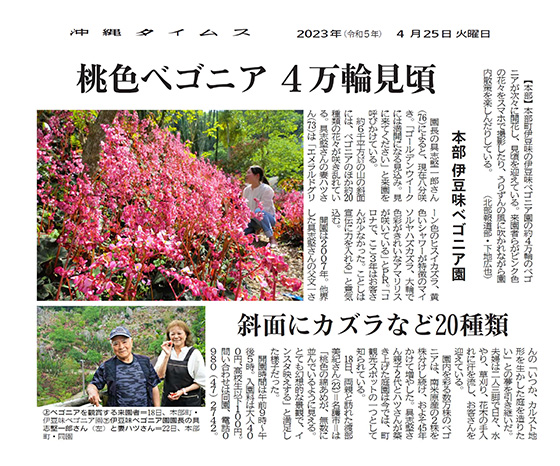
Okinawa Times Tuesday, April 25, 2023
About 40,000 begonias in the Izumi Begonia Garden in Izumi, Motobu Town, Okinawa Prefecture have blossomed one after another and are now at their peak. Visitors are enjoying taking pictures of the pink flowers with their cell phones and strolling around the park while feeling the Urizun, early summer, breeze. (Hiroya Shimoji, Northern Press Department)
According to Mr. Ichiro Gushiken, 76, the director of the garden, the trees are currently about eighty percent in bloom. “The flowers are expected to be in full bloom during Golden Week," he added, "so please come and enjoy them.”
A mountain slope of about 6,000 square meters is covered with begonias and about twenty other types of flowers, also in full bloom. Mr. Gushiken’s wife, Hatsu, 73, actively promotes the flowers, saying, “There are emerald green color Jade vine, yellow and brick color Thunbergia Mysorensis, and large, colorful amaryllis are now blooming.” She explained that “Due to the Corona pandemic we have had very few visitors for the last three years. We will more focus on advertising the garden this year.”
This garden opened its gates in 2007. Mr. Gushiken inherited the dream of his late father, Bunichi, who said, “Someday, I want to create a garden that makes the most of the karst topography.” The couple works very hard together everyday watering, mowing, and taking care of the flowers and trees to welcome visitors.
The garden began with two plants’ roots native to South America that were divided many times and which, over 45 years, grew to tens of thousands of begonia plants that decorate the garden. The garden, built by two generations of Gushikens, as well as Hatsu, is now known as one of the town’s sightseeing spots.
Miki Watabe, 23, from Nago City, who visited with her parents on April 18th, said, “It looks like countless rows of pink cotton candy. It's fantastic view and looks great on Instagram.”
The garden is open from 9:00 am to 5:00 pm. Admission is 400 yen for adults and 100 yen for high school students and those younger. For inquiries, please call the park at 0980 (47) 2742.
About 40,000 begonias in the Izumi Begonia Garden in Izumi, Motobu Town, Okinawa Prefecture have blossomed one after another and are now at their peak. Visitors are enjoying taking pictures of the pink flowers with their cell phones and strolling around the park while feeling the Urizun, early summer, breeze. (Hiroya Shimoji, Northern Press Department)
According to Mr. Ichiro Gushiken, 76, the director of the garden, the trees are currently about eighty percent in bloom. “The flowers are expected to be in full bloom during Golden Week," he added, "so please come and enjoy them.”
A mountain slope of about 6,000 square meters is covered with begonias and about twenty other types of flowers, also in full bloom. Mr. Gushiken’s wife, Hatsu, 73, actively promotes the flowers, saying, “There are emerald green color Jade vine, yellow and brick color Thunbergia Mysorensis, and large, colorful amaryllis are now blooming.” She explained that “Due to the Corona pandemic we have had very few visitors for the last three years. We will more focus on advertising the garden this year.”
This garden opened its gates in 2007. Mr. Gushiken inherited the dream of his late father, Bunichi, who said, “Someday, I want to create a garden that makes the most of the karst topography.” The couple works very hard together everyday watering, mowing, and taking care of the flowers and trees to welcome visitors.
The garden began with two plants’ roots native to South America that were divided many times and which, over 45 years, grew to tens of thousands of begonia plants that decorate the garden. The garden, built by two generations of Gushikens, as well as Hatsu, is now known as one of the town’s sightseeing spots.
Miki Watabe, 23, from Nago City, who visited with her parents on April 18th, said, “It looks like countless rows of pink cotton candy. It's fantastic view and looks great on Instagram.”
The garden is open from 9:00 am to 5:00 pm. Admission is 400 yen for adults and 100 yen for high school students and those younger. For inquiries, please call the park at 0980 (47) 2742.
A stray dolphin in Makiminato fishing port
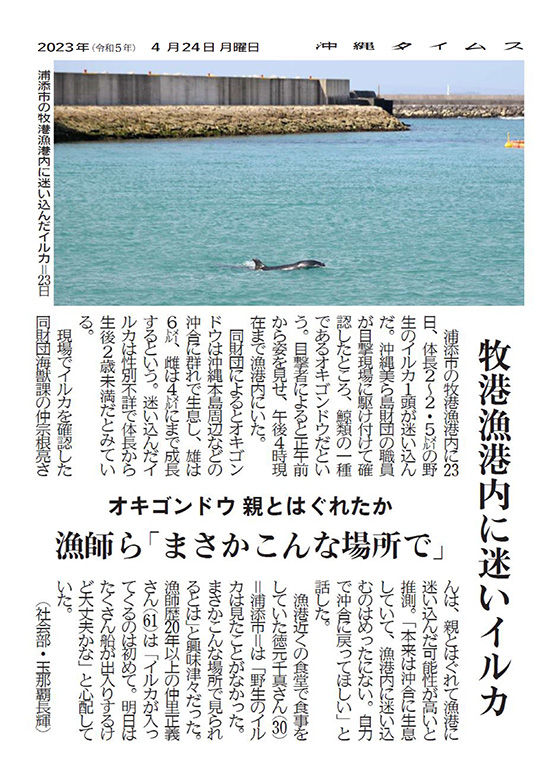
Okinawa Times, Monday, April 24, 2023
A False Killer Whale, separated from its parents?
Fishermen said, "We never expected to see one here.”
On the 23rd, a wild dolphin between 2 and 2.5 meters in length wandered into Makiminato fishing port in Urasoe City. A staff member of the Okinawa Churashima Foundation rushed to the spot where it was sighted to confirm that it was an Okigondo, a false killer whale, a type of cetacean.
According to witnesses, the dolphin appeared before noon and stayed in the fishing port until 4:00 pm. According to the Foundation, false killer whales live in groups off the coast of the main Island of Okinawa and surrounding areas, and males can grow to 6 meters and females up to 4 meters in length. The dolphin that wandered into the area was of unknown gender and is believed to be less than two years old based on its length.
Ryo Nakasone of the Marine Mammal Division of the foundation, who confirmed the dolphin at the site, speculated that it is quite possible that the dolphin wandered into the fishing port after getting separated from its parents. "These kinds of dolphins are normally found well offshore and rarely stray into fishing ports," he said. "We hope this one will return to the offshore area on its own."
Kazuma Tokugen, 30, from Urasoe City, who was eating at a restaurant near a fishing port, said, excitedly, “I’ve never seen a wild dolphin, and am so surprised to see them in a place like this.” Masayoshi Nakazato, 61, a fisherman for more than twenty years, said, “This is the first time a dolphin has come into the port. I wonder if it will be safe tomorrow with so many boats coming and going.”
(Nagateru Tamanaha, Social Affairs Department)
A False Killer Whale, separated from its parents?
Fishermen said, "We never expected to see one here.”
On the 23rd, a wild dolphin between 2 and 2.5 meters in length wandered into Makiminato fishing port in Urasoe City. A staff member of the Okinawa Churashima Foundation rushed to the spot where it was sighted to confirm that it was an Okigondo, a false killer whale, a type of cetacean.
According to witnesses, the dolphin appeared before noon and stayed in the fishing port until 4:00 pm. According to the Foundation, false killer whales live in groups off the coast of the main Island of Okinawa and surrounding areas, and males can grow to 6 meters and females up to 4 meters in length. The dolphin that wandered into the area was of unknown gender and is believed to be less than two years old based on its length.
Ryo Nakasone of the Marine Mammal Division of the foundation, who confirmed the dolphin at the site, speculated that it is quite possible that the dolphin wandered into the fishing port after getting separated from its parents. "These kinds of dolphins are normally found well offshore and rarely stray into fishing ports," he said. "We hope this one will return to the offshore area on its own."
Kazuma Tokugen, 30, from Urasoe City, who was eating at a restaurant near a fishing port, said, excitedly, “I’ve never seen a wild dolphin, and am so surprised to see them in a place like this.” Masayoshi Nakazato, 61, a fisherman for more than twenty years, said, “This is the first time a dolphin has come into the port. I wonder if it will be safe tomorrow with so many boats coming and going.”
(Nagateru Tamanaha, Social Affairs Department)
Editor’s Picks
-

#196 The Steadily Evolving EM Nature Farming Method at the Blue Sky Palace - Part 6 -

#195 The Steadily Evolving EM Nature Farming Method at the Blue Sky Palace - Part 5 -

#191 Steadily Evolving EM Nature Farming Method at the Blue Sky Palace -

#190 Quantum Mechanical Effects of EM Gravitron Charcoal
- 2025
- Apr:#204 How EM Use Has Spread Throughout the Philippines
- Mar:#203 How to Use EM to Fundamentally Solve the Problem of Agricultural Residue Burning
- Feb:#202 The Spread of EM technology in Germany
- Jan:#201 The 2nd Ichiro Masaki Memorial Universal Village EM International Conference
- Jan:#200 Cleanup of the Ala Wai Canal in Hawaii, where social bonds are strengthened using EM
- 2024
- Nov:#199 EM trials in India with bananas, tomatoes, and pomegranates
- Oct:#198 The Steadily Evolving EM Nature Farming Method at the Blue Sky Palace - Part 8
- Sep:#197 The Steadily Evolving EM Nature Farming Method at the Blue Sky Palace - Part 7
- Aug:#196 The Steadily Evolving EM Nature Farming Method at the Blue Sky Palace - Part 6
- Jul:#195 The Steadily Evolving EM Nature Farming Method at the Blue Sky Palace - Part 5
- Jun:#194 Steadily Evolving EM Nature Farming Method at the Blue Sky Palace - Part 4
- May:#193 Steadily Evolving EM Nature Farming Method at the Blue Sky Palace - Part 3
- May:#192 Steadily Evolving EM Nature Farming Method at the Blue Sky Palace - Part 2
- Apr:#191 Steadily Evolving EM Nature Farming Method at the Blue Sky Palace
- Mar:#190 Quantum Mechanical Effects of EM Gravitron Charcoal
- Mar:#189 The barrier space in Okinawa (Ryukyu Islands) has risen to another dimension
- Jan:#188 Sixty Days after Typhoon No.6
- 2023
- Oct:#187 Supermassive Typhoon No.6 and Subsequent Typhoon No. 11
- Sep:#186 Massive Typhoon No.6 that swallowed the Ryukyu Islands Graviton barrier
- Sep:#185 August 8th is World “EM Mudball Day”
- Aug:#184 A disease-free life depends on the health of the intestinal microbiome.
- Jul:#183 Trial and Error at the Blue-Sky Palace, Part 3
- Jun:#182 Trial and Error at the Blue-Sky Palace, Part 2
- Apr:#181 Trial and Error at the Blue-Sky Palace
- Mar:#180 Ala Wai Canal Cleanup Project in Waikiki, Hawaii
- Feb:#179 High-Yield, High-Quality Rice Production Using EM
- Feb:#178 The Progress the "Soil Preparation Workshop" of the Oishi 3-chan Club (Part 2)
- Jan:#177 Organic Farming Instructional Manual Using EM
- 2022
- Nov:#176 The Typhoon Situation in Okinawa in 2022
- Sep:#175 Third-Party Verification of the Graviton barrier in Okinawa Part-2
- Sep:#174 Third-Party Verification of the Graviton barrier in Okinawa
- Aug:#173 Ecosystem Changes Observed in Okinawa in 2021 Part-5
- Jun:#172 Ecosystem Changes Observed in Okinawa in 2021 Part-4
- May:#171 Ecosystem Changes Observed in Okinawa in 2021 Part-3
- Apr:#170 Ecosystem Changes Observed in Okinawa in 2021 Part-2
- Mar:#169 Koizumi Farm in Kamakura Continues to Evolve
- Feb:#168 Ecosystem Changes Observed in Okinawa in 2021 Part-1
- 2021
- Dec:#167 Enjoying EM Technology While Enriching the Local Ecosystem
- Nov:#166 A Case Study of the Use of EM in a Next Generation Free School in Tune with the Cycles of Nature
- Oct:#165 Typhoon conditions and flowers in Okinawa from August to October
- Sep:#164 Re-learning the origins of river purification using EM Cleaning up the Dairyuji River in Senami (Murakami City, Niigata Prefecture)
- Aug:#163 Measures Against Natural Disasters and Re-learning the Starting Point of EM
- Jul:#162 Summary of FFC (Foods for Children) Okinawa Forum 2021
- Jun:#161 Restoring the Vigor of an Old Tree and Purifying the Environment with EM Technology That Even an Amateur Can Do
- May:#160 The Public is Beginning to Recognize the Use of EM Smokeless Carbonizers
- Apr:#159 EM Hado (EM Graviton) that exerts quantum superposition effect over time
- Mar:#158 Virus-free Okinawan Plants Through Use of an EM Graviton Barrier
- Jan:#157 Enjoyable Farming for Self-Sufficiency that Even Amateurs Can Do
- 2020
- Dec:#156 EM quantum energy effect occurring in Okinawa
- Nov:#155 Implementing EM graviton farming as a flood countermeasure for apple orchards
- Oct:#154 The Latest Book on the Practical Uses of EM "You Are the One Who Draws Out the Power of Microorganisms," by Chizuko Nomoto
- Sep:#153 Application of EM technology to long periods of rain, lack of sunshine, storms, heavy rains, etc.
- Aug:#152 EM application in Kitanakagusuku village plant waste recycling yard
- Jul:#151 Natural Disaster Countermeasures Using EM Technology: Part 2
- Jul:#150 Natural Disaster Countermeasures Using EM Technology
- May:#149 How to make your home and workplace an energy spot by living a complete EM lifestyle: creating the ultimate source of health and environmental purification
- Apr:#148 EM, Viruses and the Pandemic
- Apr:#147 New agriculture applying quantum mechanics Part 2
- Apr:#146 New agriculture applying quantum mechanics
- Apr:#145 Wonderful EM Miracle
- 2019
- Nov:#144 The movie “Revival II” and the reality of Fukushima
- Oct:#143 Boundary dome and foliar spraying of EM・X GOLD and EM 3
- Oct:#142 Kirakira (Sparkling) Summer Vegetable Festa in 2019
- Aug:#141 Excessive salt inevitably causes salt damage
- Jul:#140 Diverse applications of charcoal Part 3
- Jun:#139 Diverse applications of charcoal Part 2
- Jun:#138 Diverse applications of charcoal
- Jun:#137 Purification power of salt
- May:#136 The degree of soil contamination is a reflection of the microflora
- May:#135 Definitive use of EM barriers to deal with typhoons
- May:#134 Implementing authentic Nature Farming
- May:#133 How to enhance healthy Hado (wave energy) by EM
- May:#132 Eating Dirt (Soil)
- May:#131 Hado (Wave energy) involved in health
- May:#130 Reaffirming EM technology to realize the essence of agriculture
- May:#129 The 2nd EM Producer Networking Meeting
- Apr:#128 Understanding the application of seawater and salt in crop cultivation
- Apr:#127 Prevention of Disasters by EM Technology
- Mar:#126 Quantum overlay effective utilization of EM
- Jan:#125 EM Disaster Recovery Support Projects in 2017
- 2018
- 2017
- Aug:#121 Escape from conventional agricultural traps
- Jul:#120 Limitation and important caveats regarding utilization of salt
- Jun:#119 EM Technology to Break Through the Limits of Pesticide-Free Strawberries
- May:#118 Application of barriers using EM rectification force
- Apr:#117 The 1st EM Produce Growers' Networking Conference
- Mar:#116 Sumizo kun: The Ultimate Versatile Carbonization Equipment
- Feb:#115 How to make and use simple carbonized and rectified ash
- Jan:#114 Achievements of 2016
- 2016
- Dec:#113 Definitive Measures Against Typhoons
- Nov:#112 International Conference on Universal Village
- Oct:#111 90% of Your Body is Microbes
- Sep:#110 Disaster Countermeasures Using EM
- Aug:#109: Changes in the Natural Environment by EM Barrier Domes in Okinawa
- Jul:#108: Multi-purpose Utilization of Activated EM with Seawater and Salt
- Jun:#107: Marine Day, when EM Mudballs and Activated EM are Applied Throughout Japan
- May:#106: The Function of EM and Gravitational Waves–Part 3
- Apr:#105: The Function of EM and Gravitational Waves–Part 2
- Feb:#104: The Function of EM and Gravitational Waves
- Feb:#103: The Importance of Phototrophic Bacteria in EM
- 2015
- Dec:#102: Results of Environmental Forum "Utsukushima EM Paradise" 2015
- Nov:#101: Environmental Forum "Utsukushima EM Paradise" 2015
- Oct:#100: A New Phase of Limit Breakthrough Using EM
- Sep:#99: A New Phase of Limit Breakthrough through EM
- Aug:#98: The Tokyo Bay Area Began Creating a Truly Livable Hometown
- Jul:#97: Rectifying Effects of EM
- Jun:#96: Lake Suwa Sousei lecture
- May:#95: In Order to Further Ensure Limit Breakthrough
- Apr:#94: Theatrical Release of the Documentary Film SOSEI-Revival to Enlighten People on the New Possibilities of Microorganisms
- Mar:#93: What Underlies Limit Breakthrough (Part 2)
- Feb:#92: EM Functions to Break Through Limits
- Jan:#91: At the Start of 2015
- 2014
- Dec:#90: Looking Back at 2014
- Nov:#89: Shikoku EM FESTA 2014, Virtuous Circle Conference in Matsuyama, Ehime Prefecture
- Oct:#88: Using EM to Deal with Weather Disasters (Part 2)
- Sep:#87: Current Status of Radioactivity Measures Using EM in Fukushima
- Aug:#86: APNAN (Asia Pacific Natural Agriculture Network) 25th Anniversary Conference in 2014
- Jul:#85: Using EM to Deal with Weather Disasters
- Jun:#84: Substantial Improvement of Soil
- May:#83: The Energy Rectification Force of EM
- Apr:#82: The Annual 18th EM Technology Exchange Meeting and Tohoku Conference in Shichigahama
- Mar:#81: Salmon going upstream in Kitaura (Kasumigaura)
- Feb:#80: The Microbiome Again
- Jan:#79: Inauguration of the Federation of Diet Members Who Use and Apply Effective Microorganisms
- 2013
- Dec:#78: Receiving an Honorary Doctoral Degree from Rajamangala University of Technology in Thailand
- Nov:#77: The Use of EM in School Education in Bhutan
- Oct:#76: Well of Bonding
- Sep:#75: The Background to EM Not Being Employed by Public Institutions to Deal with Radiation
- Aug:#74: Dealing with Disaster: Using EM in Crisis Management
- Jul:#73: EM Events on Ocean Day
- Jun:#72: Using EM to Deal With Heat Stroke and Summer Heat Fatigue
- May:#71: An EM Model Town in Malaysia
- Apr:#70: Steps the Japanese Government is Taking to Deal with Radiation: Are They Really Safe?
- Mar:#69: EM Group Disaster Reconstruction Aid Project in Fukushima
- Feb:#68: EM and Microbiomes (Microbial Flora)
- Jan:#67: A Necessary Evil is Still Evil
- 2012
- Dec:#66: The 17th National EM Technology Exchange Conference / Hokkaido Conference in Sapporo
- Nov:#65: EM Forum 2012 in Okinawa and the Environmental Forum in Fukushima
- Oct:#64: 2012 EM Forum
- Sep:#63: A New Earth Saving Revolution
- Aug:#62: The Asahi Newspaper’s Misguided Reports About EM
- Jul:#61: Using EM in Radioactive Contamination Measures in Fukushima Prefecture
- Jun:#60: The Effects of Using EM to Inhibit the Absorption of Radioactivity as Confirmed in Fukushima
- May:#59: Recovery Support for the Great East Japan Earthquake
- Apr:#58: The Royal Kingdom of Thailand, in which EM Functions as a Set Government Policy
- Mar:#57: Report on the Measures Taken by Kingdom of Thailand Using EM to Deal with Polluted Water
- Feb:#56 EM™ as Part of National Policy in Thailand to Deal with Sanitation Issues Resulting from the Flood of 2011
- Jan:#55 The Law of Syntropy (Revitalization)
- 2011
- Dec:#54 EM Forum 2011
- Nov:#53 Shikoku EM Festa 2011- Zenjunkan no Wa (Virtuous Circle) Tokushima Conference in Naruto -
- Oct:#52 The Mystery of Interim Safety Values for Radioactive Material
- Sep:#51 Successful Radiation Countermeasures Using EM
- Aug:#50 Events on Sea Day in which EM Mud Balls are Thrown into the Water and Activated EM is Applied.
- May:#47 Dealing with the Damage Caused by the Eastern Japan Earthquake
- Apr:#46 Eastern Japan Earthquake
- Mar:#45 The 16th National EM Technology Hokuriku Conference in Fukui
- Feb:#44 More Thoughts on Avian Influenza and Foot-and-Mouth Disease
- Jan:#43 Happy New Year!
- 2010
- Dec:#42 Shikoku EM FESTA 2010・Zenjunkan no wa (Virtuous Circle) Fellowship Conference in Tobe, Ehime Prefecture
- Nov:#41 EM Forum 2010
- Oct:#40: My Thanks to the EM™ Volunteers Who Helped in the Fight Against Foot-and-Mouth Disease in Miyazaki Prefecture
- Sep:#39 International EM Mud Ball Day
- Jul:#37 Poland EM Forum 2010
- Jun:#36 EM Countermeasures Against Foot-and-Mouth Disease
- May:#35 Abnormal Weather
- Apr:#34 EM Activities in Thailand: Finding Solutions to the Challenges Facing the Nation
- Mar:#33 New Developments in the Evolution of EMTM in Thailand
- Feb:#32 Results Starting to Be Seen at the Mikasa Project
- Jan:#31 Towards an EM-Use Society
- 2009
- Dec:#30 EM Summit
- Nov:#29 The System in Penang State in Malaysia that Made the World EMTM Mudball Day a Success
- Oct:#28 The "World EM Mudball Day" in Malaysia
- Sep:#27 Validating EMTM Medicine: Case Study Reports from EM Users 2009. (Part 3)
- Sep:#26 Validating EMTM Medicine: Case Study Reports from EMTM Users 2009. (Part 2)
- Jul:#25 Validating EMTM Medicine: Case Study Reports from EMTM Users 2009. (Part 1)
- Jun:#24 Activities to Disseminate EM-Focused Nature Farming in China
- May:#23 Use of EMTM in Response to Swine Flu
- Apr:#22 Using EM to Solve Public Administrative Costs
- Mar:#21 Reaffirming the Versatility of EM
- Jan:#20 The Beginning of a New Era
- 2008
